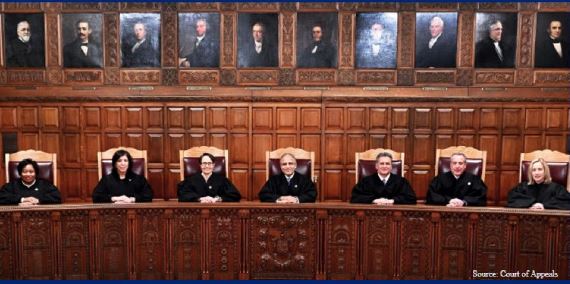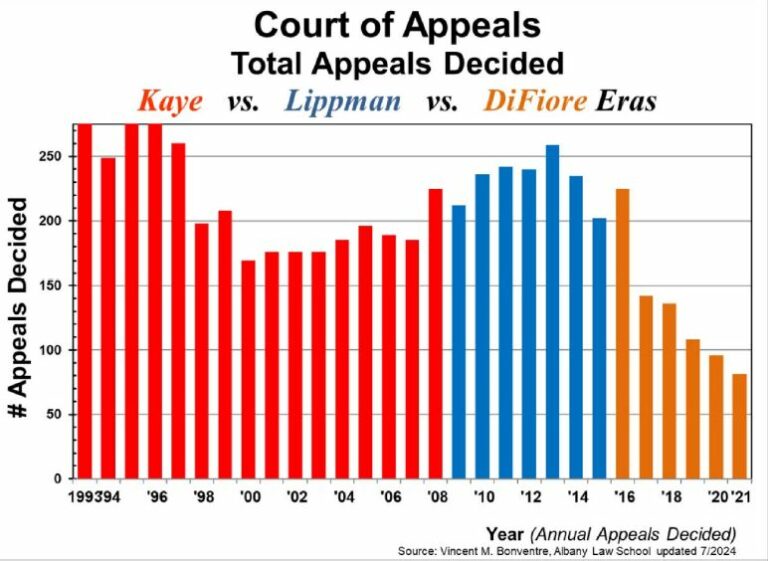The Changing Faces of the New York Court of Appeals
8.30.2024

It’s been a little over a year since Chief Judge Rowan Wilson was sworn in as the chief judge of the State of New York. In this short time, the state’s highest court has seen changes in how the court operates and the number of appeals it hears.
The Miranda Warnings Roundtable, which was released today, focused on the changing faces at New York’s Court of Appeals, its highest court. Host David Miranda was joined by Albany Law professor Vin Bonventre and political strategist Liz Benjamin.
Bonventre recently published articles and presented a continuing legal education program using his analysis of court data on the cases heard and decisions rendered by the New York Court of Appeals. He tracked the court’s work from the terms of Chief Judges Judith Kaye, Jonathan Lippman and Janet DiFiore.

“In the DiFiore era, the number of cases that the court would decide plummeted. It went down from about 250 cases a year at its high to 70. Now under Rowan Wilson, the court this year heard 103 cases.”
Political strategist Liz Benjamin took issue with Bonventre’s idea that quantity matters.
“Why do we think that the court needs to demonstrate its worth by taking on more and more cases as long as they make decisions that are meaningful, and they consider them thoughtfully, and they issue opinions that are well thought out. Isn’t that enough?” she said.
Hearing More Criminal Appeals
Bonventre tracked the number of criminal appeals under Wilson, which have virtually doubled since taking leadership of the court. In the last year of Chief Judge DiFiore’s term, the court heard 29 criminal appeals. In less than one year, Judge Wilson’s court heard 51 criminal appeals.
“That’s positive but also begs the question as to why, what the hell was wrong before?” said Benjamin. “If there’s an appeal, then there’s a chance that the case will be overturned, and just like we had in this session in the Weinstein case.”
Benjamin was referring to the Court of Appeals in April 2024 overturning movie producer Harvey Weinstein’s conviction on felony sex crime charges.
Bonventre says the decision about whether the court will hear a appeal in a criminal matter can depend on which judge is evaluating the case.
“If your criminal leave application goes to a judge like Wilson, you have a good chance,” Bonventre said. “If it goes to somebody like (Associate Judge Michael) Garcia, you will virtually have no chance that it will be heard.”
Ideological Shift Under Chief Judge Wilson
In the short time that Wilson has led the high court, Bonventre notes a significant increase in the number of 4-3 decisions.
“We’re seeing so many, 4 to 3 cases at the Court of Appeals, you know. We used to say with pride that the Court of Appeals was nothing like the United States Supreme Court, you know where it’s divided along ideological lines,” Bonventre said. “Now, we are seeing quite a bit of division along ideological lines.”
“We are seeing a lot of 4-3 decisions on the Wilson court, but that is not terribly different than what we saw during the DiFiore or Lippman courts, but clearly different than Judge Kaye’s court,” Miranda said.
The panel contends that Kaye sought consensus on the court, which resulted in fewer close decisions and dissenting opinions. Under Lippman and DiFiore, Bonventre said the tone changed because they did not seek consensus and invited dissent.
The court’s ideological shift can be seen by looking at which judges are offering dissenting opinions.
“The fascinating thing is that when DiFiore was chief, it was usually DiFiore, (Associate Judge Anthony) Cannataro, Garcia and (Associate Judge Madeline) Singas in the majority. Those four together and Cannataro never dissented,” he said. “When he became acting chief, there was one dissent by him. Once Wilson became chief, Cannataro has been dissenting more than Wilson, 15 times in one year as opposed to zero before. I think that tells you that the direction of the court has really changed.”
You can hear the entire episode here including analysis by the panel of the Weinstein appeal.



